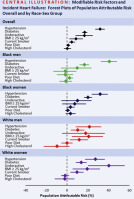当前位置:
X-MOL 学术
›
JACC Heart Fail.
›
论文详情
Our official English website, www.x-mol.net, welcomes your
feedback! (Note: you will need to create a separate account there.)
Race and Sex Differences in Modifiable Risk Factors and Incident Heart Failure.
JACC: Heart Failure ( IF 10.3 ) Pub Date : 2019-11-11 , DOI: 10.1016/j.jchf.2019.11.001 Danielle M Kubicki 1 , Meng Xu 2 , Elvis A Akwo 3 , Debra Dixon 4 , Daniel Muñoz 4 , William J Blot 5 , Thomas J Wang 4 , Loren Lipworth 6 , Deepak K Gupta 4
JACC: Heart Failure ( IF 10.3 ) Pub Date : 2019-11-11 , DOI: 10.1016/j.jchf.2019.11.001 Danielle M Kubicki 1 , Meng Xu 2 , Elvis A Akwo 3 , Debra Dixon 4 , Daniel Muñoz 4 , William J Blot 5 , Thomas J Wang 4 , Loren Lipworth 6 , Deepak K Gupta 4
Affiliation

|
OBJECTIVES
The purpose of this study was to examine race- and sex-based variation in the associations between modifiable risk factors and incident heart failure (HF) among the SCCS (Southern Community Cohort Study) participants.
BACKGROUND
Low-income individuals in the southeastern United States have high HF incidence rates, but relative contributions of risk factors to HF are understudied in this population.
METHODS
We studied 27,078 black or white SCCS participants (mean age: 56 years, 69% black, 63% women) enrolled between 2002 and 2009, without prevalent HF, receiving Centers for Medicare and Medicaid Services. The presence of hypertension, diabetes mellitus, physical underactivity, high body mass index, smoking, high cholesterol, and poor diet was assessed at enrollment. Incident HF was ascertained using International Classification of Diseases-9th revision, codes 428.x in Centers for Medicare and Medicaid Services data through December 31, 2010. Individual risk and population attributable risk for HF for each risk factor were quantified using multivariable Cox models.
RESULTS
During a median (25th, 75th percentile) 5.2 (3.1, 6.7) years, 4,341 (16%) participants developed HF. Hypertension and diabetes were associated with greatest HF risk, whereas hypertension contributed the greatest population attributable risk, 31.8% (95% confidence interval: 27.3 to 36.0). In black participants, only hypertension and diabetes associated with HF risk; in white participants, smoking and high body mass index also associated with HF risk. Physical underactivity was a risk factor only in white women.
CONCLUSIONS
In this high-risk, low-income cohort, contributions of risk factors to HF varied, particularly by race. To reduce the population burden of HF, interventions tailored for specific race and sex groups may be warranted.
中文翻译:

可改变的危险因素中的种族和性别差异以及突发性心力衰竭。
目的本研究的目的是检查SCCS(南方社区研究)参与者中可改变的危险因素与事件性心力衰竭(HF)之间的种族和性别差异。背景技术在美国东南部的低收入人群中,HF的发病率很高,但是在这一人群中,人们对危险因素对HF的相对贡献进行了研究。方法我们研究了2002年至2009年之间接受了Medicare和Medicaid Services中心治疗的27,078名黑人或白人SCCS参与者(平均年龄:56岁,黑人69%,女性63%),他们没有普遍的HF。在入组时评估了高血压,糖尿病,身体活动不足,高体重指数,吸烟,高胆固醇和不良饮食的存在。截至2010年12月31日,使用国际疾病分类第9版(代码428.x)在医疗保险和医疗补助中心获得的数据确定了HF的发病率。使用多变量Cox模型对每种危险因素的HF个人风险和人群可归因风险进行了量化。结果在中位(第25、75个百分位数)5.2(3.1,6.7)年中,有4,341(16%)名参与者患了心力衰竭。高血压和糖尿病与最大的心力衰竭风险有关,而高血压是最大的人群归因风险,为31.8%(95%置信区间:27.3至36.0)。在黑人参与者中,仅高血压和糖尿病与HF风险有关;在白人参与者中,吸烟和高体重指数也与HF风险有关。体力活动不足仅是白人女性的危险因素。结论在这一高风险,低收入人群中,危险因素对HF的贡献各不相同,尤其是种族差异。为了减轻HF的人口负担,可能需要针对特定种族和性别人群进行干预。
更新日期:2019-11-11
中文翻译:

可改变的危险因素中的种族和性别差异以及突发性心力衰竭。
目的本研究的目的是检查SCCS(南方社区研究)参与者中可改变的危险因素与事件性心力衰竭(HF)之间的种族和性别差异。背景技术在美国东南部的低收入人群中,HF的发病率很高,但是在这一人群中,人们对危险因素对HF的相对贡献进行了研究。方法我们研究了2002年至2009年之间接受了Medicare和Medicaid Services中心治疗的27,078名黑人或白人SCCS参与者(平均年龄:56岁,黑人69%,女性63%),他们没有普遍的HF。在入组时评估了高血压,糖尿病,身体活动不足,高体重指数,吸烟,高胆固醇和不良饮食的存在。截至2010年12月31日,使用国际疾病分类第9版(代码428.x)在医疗保险和医疗补助中心获得的数据确定了HF的发病率。使用多变量Cox模型对每种危险因素的HF个人风险和人群可归因风险进行了量化。结果在中位(第25、75个百分位数)5.2(3.1,6.7)年中,有4,341(16%)名参与者患了心力衰竭。高血压和糖尿病与最大的心力衰竭风险有关,而高血压是最大的人群归因风险,为31.8%(95%置信区间:27.3至36.0)。在黑人参与者中,仅高血压和糖尿病与HF风险有关;在白人参与者中,吸烟和高体重指数也与HF风险有关。体力活动不足仅是白人女性的危险因素。结论在这一高风险,低收入人群中,危险因素对HF的贡献各不相同,尤其是种族差异。为了减轻HF的人口负担,可能需要针对特定种族和性别人群进行干预。











































 京公网安备 11010802027423号
京公网安备 11010802027423号